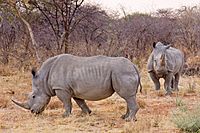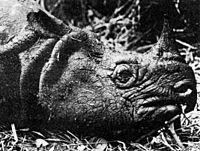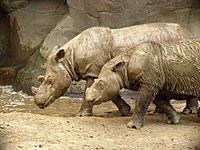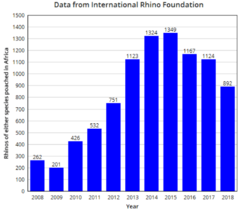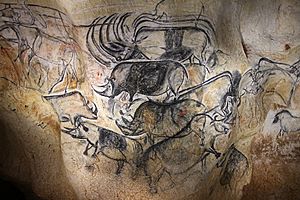Rhinoceros facts for kids
Quick facts for kids Rhinoceros |
|
|---|---|
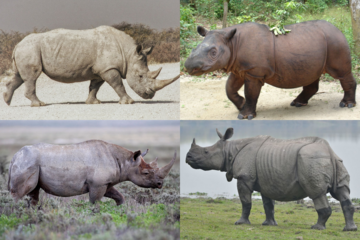 |
|
| Rhinoceros species of different genera; from top-left, clockwise: white rhinoceros (Ceratotherium simum), Sumatran rhinoceros (Dicerorhinus sumatrensis), Indian rhinoceros (Rhinoceros unicornis), black rhinoceros (Diceros bicornis) | |
| Scientific classification |
|
| Kingdom: | Animalia |
| Phylum: | Chordata |
| Class: | Mammalia |
| Order: | Perissodactyla |
| Superfamily: | Rhinocerotoidea |
| Family: | Rhinocerotidae Owen, 1845 |
| Type genus | |
| Rhinoceros Linnaeus, 1758
|
|
| Extant and subfossil genera | |
|
Ceratotherium |
|
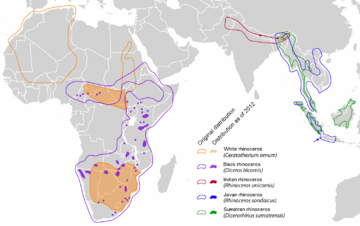 |
|
| Rhinoceros range | |
A rhinoceros (pronounced ry-NOSS-uh-russ), often called a rhino, is a huge, plant-eating mammal. The name "rhinoceros" comes from ancient Greek words meaning "nose-horned." There are five types of rhinos alive today, and many more that are now extinct. Two of these living species are found in Africa, and three live in Asia.
Rhinos are some of the biggest land animals left on Earth. Adult rhinos can weigh over half a ton! They eat only plants (they are herbivores). Rhinos have a thick, tough skin that can be up to 5 centimeters (2 inches) thick. This skin is made of strong layers of a material called collagen. They also have one or two horns on their nose.
Sadly, rhinos are in danger. Poachers hunt them for their horns, which are sold illegally for very high prices. This has made most rhino species endangered. Rhino horns are made of keratin, the same stuff as your hair and fingernails. There's no real proof that rhino horn has any health benefits, even though it's used in some traditional medicines.
Contents
Description
Rhinos are among the biggest land animals. The smallest living rhino is the Sumatran rhinoceros, weighing about 775 kg (1,700 lbs). The largest is the white rhinoceros, which can weigh up to 2,300 kg (5,000 lbs). Some extinct rhinos were even bigger!
Rhinos have strong, thick bones in their legs. They also have three toes on each foot. Their skin is very tough and looks like armor, with deep folds. Most rhinos have gray to brown skin and not much hair, except for their eyelashes, ears, and tail. The Sumatran rhino is an exception, often having a lot of hair.
Rhino horns are made of a material called keratin, just like your fingernails. They grow from a rough area on the rhino's skull. Not all ancient rhinos had horns, but all living species do. Rhinos have small brains for their size, around 531 grams (about 1.2 lbs) in an adult black rhino.
Behavior and reproduction
Rhinos spend most of their time looking for food. They are hindgut fermenters, meaning they digest their food in a special part of their gut. This allows them to eat tough plant material if needed.
Male rhinos usually live alone. Female Asian rhinos also tend to be solitary. However, female African rhinos sometimes form groups, especially white rhinos.
When it's time to mate, both male and female rhinos look for several partners. Males will guard females who are ready to mate. Sometimes, male rhinos fight over females, which can lead to serious injuries.
Rhino pregnancies last a long time, over a year! A black rhino's pregnancy is about 460 days, and a white rhino's is about 504 days. The mother usually gives birth in a quiet spot. Baby rhinos, called calves, can stand up within 30 minutes of being born. They stay close to their mothers for a long time. Young rhinos can be hunted by large predators until they are about three years old. Mothers are very protective of their calves. Rhinos become ready to have their own babies around five to eight years old.
Types of Rhinos
There are five types of rhinos alive today. Each one is unique!
White Rhinoceros
The white rhinoceros is the most common rhino species. There are two types: the southern white rhino and the critically endangered northern white rhino. The name "white" might come from an old Dutch word meaning "wide," referring to its wide, flat lips used for grazing grass.
White rhinos are very large, with a big head and broad chest. They can weigh up to 2,400 kg (5,300 lbs) on average. They have two horns, with the front horn being larger. Their color can be yellowish-brown to slate gray.
Black Rhinoceros
The black rhinoceros is named to tell it apart from the white rhino, but both species are actually similar in color. There are four types (subspecies) of black rhinos, but one, the West African black rhino, was declared extinct in 2011.
Black rhinos are smaller than white rhinos. They stand about 1.5 to 1.75 meters (5 to 5.7 feet) tall at the shoulder. They have a pointed, beak-shaped lip, which they use to grab leaves and twigs when eating. Sadly, their numbers dropped sharply in the late 1900s due to poaching, but they are slowly increasing again.
Indian Rhinoceros
The Indian rhinoceros, also called the greater one-horned rhinoceros, has a single horn. It's almost as big as the African white rhino. Its thick, silver-brown skin folds, making it look like it's wearing armor.
Indian rhinos used to live across many parts of Asia. Now, they are found only in a few protected areas in India and Nepal. Two-thirds of the world's Indian rhinos live in Kaziranga National Park in India.
Javan Rhinoceros
The Javan rhinoceros is one of the most endangered large mammals in the world. As of 2015, only about 60 of them remain, all in Ujung Kulon National Park in Java, Indonesia. It's also the least known rhino species.
Like the Indian rhino, the Javan rhino has a single horn. Its skin is hairless and hazy gray, with folds that look like armor. They prefer dense rainforests with lots of floodplains and mud wallows. Poaching for their horns has driven them to the brink of extinction.
Sumatran Rhinoceros
The Sumatran rhinoceros is the smallest rhino species and the one with the most hair. It lives in high-altitude areas of Borneo and Sumatra. Due to habitat loss and poaching, its numbers have dropped, making it the second most endangered rhino.
Sumatran rhinos typically weigh around 700 kg (1,500 lbs). Like the African rhinos, they have two horns, with the front one being larger. Their hair can be dense, especially in young calves, and their color is reddish-brown. Sumatran rhinos are closely related to the extinct woolly rhinoceros.
History
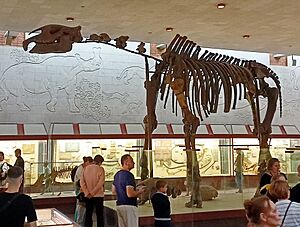
The very first rhino ancestors appeared in Asia about 54 million years ago. Modern rhino families appeared around 39-40 million years ago in North America and Asia. Rhinos spread into Europe about 34 million years ago.
Rhinos were most diverse during the Miocene epoch, about 20 million years ago. At that time, many different rhino species lived together in places like Eurasia. However, their numbers declined later due to climate changes.
Some rhino species, like the woolly rhinoceros, lived alongside humans during the Ice Age. Their images can be found in ancient cave paintings in Europe.
Threats
Adult rhinos have no natural predators other than humans. Young rhinos, however, can sometimes be hunted by large cats, crocodiles, wild dogs, and hyenas.
The biggest threat to rhinos is poaching. Poachers kill rhinos for their horns, which are then sold illegally. This trade is driven by demand in places like China and Vietnam, where the horns are used in traditional medicine, even though there's no scientific proof of their benefits. In Yemen, rhino horns are also used to make dagger handles.
Poaching has increased dramatically in recent years. In South Africa, thousands of rhinos have been killed.
Conservation
Many people and organizations are working hard to save rhinos. In some areas, rhinos are tranquilized, and their horns are carefully removed by experts. This makes the rhinos less attractive to poachers. Armed park rangers also patrol areas to protect rhinos and catch poachers.
Some conservationists have tried injecting rhino horns with a special dye and a chemical that is safe for rhinos but toxic to humans. The dye also makes the horn visible on X-ray scanners, even if it's ground into powder. Signs are posted to warn potential buyers that the horns are treated. However, some groups question how effective this method is, especially since horns are also bought for decoration.
Another idea is to create artificial rhino horns using biotechnology. If these fake horns could be made and sold, it might reduce the demand for real rhino horns. This could help stop poaching by making the illegal trade less profitable.
Rhinos in History and Art
Rhinos have been part of human culture for a very long time.
- Ancient cave paintings in France, dating back tens of thousands of years, show woolly rhinoceroses.
- In ancient China, bronze statues of rhinos were made.
- The Greek historian Agatharchides mentioned rhinos in his writings in the 2nd century BC.
- In some Asian cultures, the Hindu god Agni is shown riding a rhinoceros.
- In 1515, the famous artist Albrecht Dürer created a well-known woodcut of a rhinoceros, even though he had never seen one himself! His drawing was based on descriptions and a sketch.
- There are old legends in places like Burma and Malaysia about rhinos stamping out forest fires. This idea was even shown in the movie The Gods Must Be Crazy.
- In 1974, a lavender rhinoceros became a symbol for the gay community in Boston, United States.
Rhino Family Tree
|
|||||||||||||||||||||||||||
| Cladogram following a phylogenetic study |
The word rhinoceros comes from ancient Greek. It means "nose-horned," which perfectly describes these animals! People have used this name for rhinos since the 1300s.
Today, there are four main groups (genera) of rhinos:
- Ceratotherium (white rhinoceros)
- Diceros (black rhinoceros)
- Dicerorhinus (Sumatran rhinoceros)
- Rhinoceros (Indian and Javan rhinoceros)
The two African species, the white rhinoceros and the black rhinoceros, split into separate species about 5 million years ago. A key difference between them is their mouths. White rhinos have wide, flat lips for eating grass, while black rhinos have pointed lips for grabbing leaves and twigs. The Indian rhinoceros and Javan rhinoceros are Asian species that separated about 10 million years ago. The Sumatran rhinoceros is the only living member of its group.
See Also
- Bardiya National Park
- Chitwan National Park
- Care For Wild Rhino Sanctuary
- International Rhino Foundation
- Kaziranga National Park
- List of odd-toed ungulates by population
- Nicolaas Jan van Strien
- Save the Rhino
- TRAFFIC
Individual Rhinoceroses
- Abada
- Clara
- List of fictional pachyderms
- Rhinoceros of Versailles
Literature
- Rhinoceros, 1959 play
Other
- Rhinoceroses in ancient China
See also
 In Spanish: Rinocerontes para niños
In Spanish: Rinocerontes para niños


